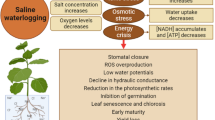Abstract
Impeded gas exchange is a primary constraint for plants in wetland and aquatic environments. Excess water can interrupt O2 supply for respiration causing “energy crises” and when shoots are submerged restrict CO2 supply for photosynthesis with adverse effects on the carbohydrate economy. Other major constraints include soil-generated phytotoxins and self-generated reactive oxygen species (ROS).
Similar content being viewed by others
References
Armstrong W. Aeration in higher plants. Adv Bot Res. 1979;7:225–332.
Armstrong W, Beckett PM. Experimental and modelling data contradict the idea of respiratory down-regulation in plant tissues at an internal [O2] substantially above the critical oxygen pressure for cytochrome oxidase. New Phytol. 2011;190:431–41.
Armstrong J, Armstrong W, Beckett PM. Phragmites australis: venturi- and humidity-induced pressure flows enhance rhizome aeration and rhizosphere oxidation. New Phytol. 1992;120:197–207.
Armstrong W, Strange ME, Cringle S, Beckett PM. Microelectrode and modelling study of oxygen distribution in roots. Ann Bot. 1994;74:287–99.
Armstrong W, Cousins D, Armstrong J, Turner DW, Beckett PM. Oxygen distribution in wetland plant roots and permeability barriers to gas-exchange with the rhizosphere: a microelectrode and modelling study with Phragmites australis. Ann Bot. 2000;86:687–703.
Bailey-Serres J, Voesenek LACJ. Flooding stress: acclimations and genetic diversity. Annu Rev Plant Biol. 2008;59:313–39.
Beckett PM, Armstrong W, Justin SHFW, Armstrong J. On the relative importance of convective and diffusive gas-flows in plant aeration. New Phytol. 1988;110:463–8.
Blokhina O, Virolainen E, Fagerstat KV. Antioxidants, oxidative damage and oxygen deprivation stress: a review. Ann Bot. 2003;91:179–94.
Brix H, Sorrell BK, Orr P. Internal pressurization and convective gas flow in some emergent freshwater macrophytes. Limnol. Oceanogr. 1992;37:1420–33.
Colmer TD, Voesenek LACJ. Flooding tolerance: suites of plant traits in variable environments. Funct Plant Biol. 2009;36:665–81.
Colmer TD, Winkel A, Pedersen O. A perspective on underwater photosynthesis in submerged terrestrial wetland plants. AoB Plants. 2011; plr030. doi:10.1093/aobpla/plr030.
Gibbs J, Greenway H. Mechanisms of anoxia tolerance in plants. I. Growth, survival and anaerobic catabolism. Funct Plant Biol. 2003;330:1–47.
Gibbs DJ, Lee SC, Isa NM, Gramuglia S, Fukao T, et al. Homeostatic response to hypoxia is regulated by the N-end rule pathway in plants. Nature. 2011;479:415–8.
Greenway H, Gibbs J. Mechanisms of anoxia tolerance in plants. II. Energy requirements for maintenance and energy distribution to essential processes. Funct Plant Biol. 2003;30:999–1036.
Greenway H, Armstrong W, Colmer TD. Conditions leading to high CO2 (>5 kPa) in waterlogged–flooded soils and possible effects on root growth and metabolism. Ann Bot. 2006;98:9–32.
Justin SHFW, Armstrong W. The anatomical characteristics of roots and plant response to soil flooding. New Phytol. 1987;106:465–95.
Licausi F, Perata P. Low oxygen signaling and tolerance in plants. Adv Bot Res. 2009;50:139–98.
Licausi F, Kosmacz M, Weits DA, Giuntoli B, Giorgi FM, Voesenek LACJ, Perata P, van Dongen JT. Oxygen sensing in plants is mediated by an N-end rule pathway for protein destabilization. Nature. 2011;479:419–22.
Maberly SC, Madsen TV. Freshwater angiosperm carbon concentrating mechanisms: processes and patterns. Funct Plant Biol. 2002;29:393–405.
Mira M, Hill RD, Stasolla C. Regulation of programmed cell death by phytoglobins. J Exp Bot. 2016; doi: 10.1093/jxb/erw259.
Pedersen O, Sand-Jensen K, Revsbech NP. Diel pulses of O2 and CO2 in sandy sediments inhabited by Lobelia Dortmanna. Ecology. 1995;76:1536–1545.
Voesenek LACJ, Colmer TD, Pierik R, Millenaar FF, Peeters AJM. How plants cope with complete submergence. New Phytol. 2006;170:213–26.
Watanabe K, Nishiuchi S, Kulichikhin K, Nakazono M. Does suberin accumulation in plant roots contribute to waterlogging tolerance? Front Plant Sci. 2013;4(179):1–7.
Waters I, Armstrong W, Thomson CJ, Setter TL, Adkins S, Gibbs J, Greenway H. Diurnal changes in radial oxygen loss and ethanol metabolism in roots of submerged and non-submerged rice seedlings. New Phytol. 1989;113:439–51.
Winkel A, Colmer TD, Ismail AM, Pedersen O. Internal aeration of paddy field rice (Oryza sativa L.) during complete submergence: importance of light and floodwater O2. New Phytol. 2013;197:1193–203.
Yamauchi T, Rajhi I, Nakazono M. Lysigenous aerenchyma formation in maize root is confined to cortical cells by regulation of genes related to generation and scavenging of reactive oxygen species. Plant Signal Behav. 2011; 615:759–761.
Author information
Authors and Affiliations
Corresponding authors
Editor information
Editors and Affiliations
Rights and permissions
Copyright information
© 2016 Springer Science+Business Media Dordrecht
About this entry
Cite this entry
Armstrong, W., Colmer, T.D. (2016). Physiological Adaptations to Wetland Habitats. In: Finlayson, C., et al. The Wetland Book. Springer, Dordrecht. https://doi.org/10.1007/978-94-007-6172-8_79-2
Download citation
DOI: https://doi.org/10.1007/978-94-007-6172-8_79-2
Received:
Accepted:
Published:
Publisher Name: Springer, Dordrecht
Online ISBN: 978-94-007-6172-8
eBook Packages: Springer Reference Biomedicine and Life SciencesReference Module Biomedical and Life Sciences




